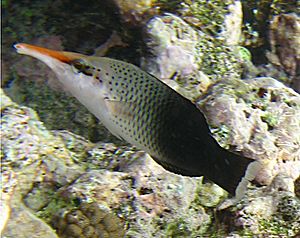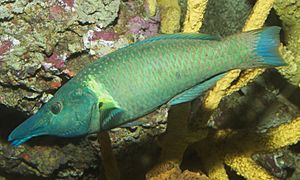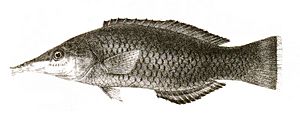Gomphosus varius facts for kids
Quick facts for kids Gomphosus varius |
|
|---|---|
 |
|
| female | |
 |
|
| male | |
| Conservation status | |
| Scientific classification | |
| Synonyms | |
|
The bird wrasse, Gomphosus varius, is a colorful fish that lives in coral reefs. It's part of the wrasse family, which has many different kinds of fish. This fish gets its name "bird wrasse" because of its long, pointy snout, which looks a bit like a bird's beak!
Contents
What Does the Bird Wrasse Look Like?
The bird wrasse is a medium-sized fish, growing up to about 30 centimeters (about 12 inches) long. It has a long, thin body that's a bit flattened on the sides. Its most special feature is its very long nose, which helps it find food.
When adult bird wrasses swim, they flap their fins in a jerky way, which makes them easy to spot. Young bird wrasses are harder to identify because their long snout hasn't grown yet.
Bird wrasses can change their body shape and color as they grow. This is because they can change their sex during their lives!
Differences Between Males and Females
Female bird wrasses are usually smaller than males. Their colors are also not as bright. The front part of a female's body is light-colored. Her belly and chest are pearly white, and her scales are grayish with dark edges. The top of her snout is reddish-orange.
Male bird wrasses have more even colors. They are mostly green, but the exact shade can change. Sometimes their heads can even be dark blue. The color of a male can also change depending on how mature he is or if it's mating season.
Where Do Bird Wrasses Live?
Bird wrasses live in the warm, tropical and subtropical waters of the Indo-Pacific region. This area stretches from the eastern part of the Indian Ocean all the way to the islands of the Pacific Ocean, including Hawaii.
They love to live near coral reefs and in lagoons. These areas are full of hard corals, which provide plenty of places to hide and find food.
How Do Bird Wrasses Live?
Bird wrasses are active during the day. They usually swim alone, but sometimes you might see them in small groups.
What Do Bird Wrasses Eat?
Bird wrasses are meat-eaters. They mostly eat small creatures that live on the ocean floor, especially tiny crustaceans found in corals. They also enjoy eating brittle stars, molluscs (like snails or clams), and even small fish. They use their long snouts to pick out food from cracks and crevices in the coral.
Life Cycle and Reproduction
The bird wrasse has a very interesting life cycle. Like many wrasses, they are "sequential hermaphrodites." This means they can change their sex during their lives.
Bird wrasses usually start out as females. Later, they can change and become males. This change affects their body shape, colors, and patterns.
See also
 In Spanish: Gomphosus varius para niños
In Spanish: Gomphosus varius para niños



